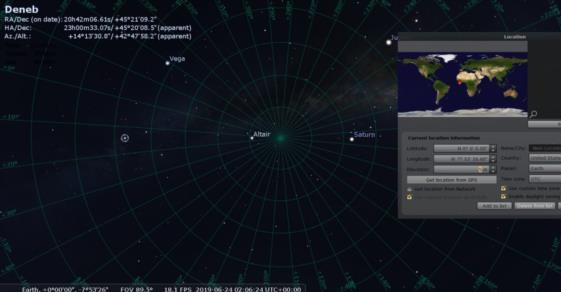
NavList:
A Community Devoted to the Preservation and Practice of Celestial Navigation and Other Methods of Traditional Wayfinding
From: Frank Reed
Date: 2019 May 17, 10:08 -0700
An even easier approach...
You want to know when Deneb, Altair, and Saturn fall on the same great circle. So pick a location and find the time of night today when Deneb and Altair have exactly the same azimuth. This is easy to do in most astronomy simulation software, like Stellarium. You can also adjust longitude once you've settled on a time that's about right, and this usually provides a finer adjustment. Then advance the date, one sidereal day at a time (alt= does this Stellarium), until Saturn appears to have nearly the same azimuth. All three bodies are now aligned on the same vertical circle, which is, of course, a great circle. Problem solved. And as described before, you can test day before/day after azimuth differences and then interpolate to get the exact UT. I find that the alignment occurs at about 02:06:24 UT on June 24, give or take a minute or two. This appears to differ significantly, by more than half an hour, from Paul and Antoine's results. But who knows... maybe I've got some setting wrong in Stellarium or maybe the results of the app are not sufficiently accurate for this task. For reference, if you go to a spot north of Stockholm, Sweden at 60°00'00.0" N, 18°09'17.9" E at the time I've given, you should find all three objects aligned on azimuth 209°26'13.8". There's another location at the same instant of time in the attached image.
Frank Reed







